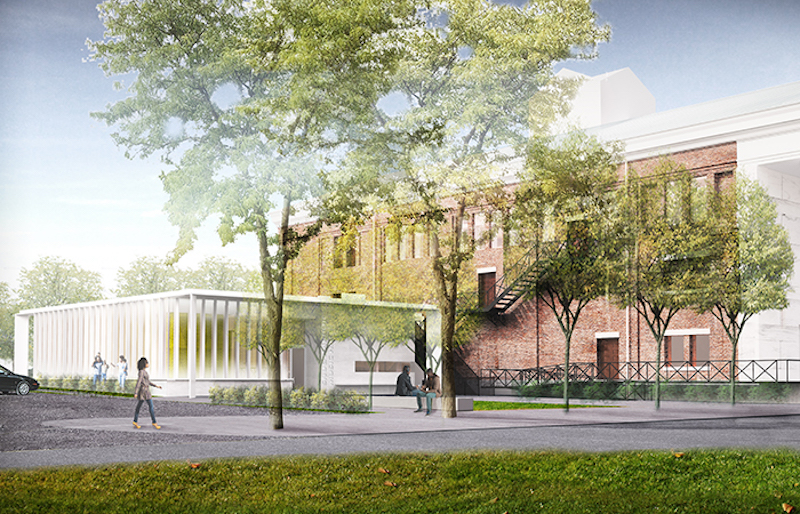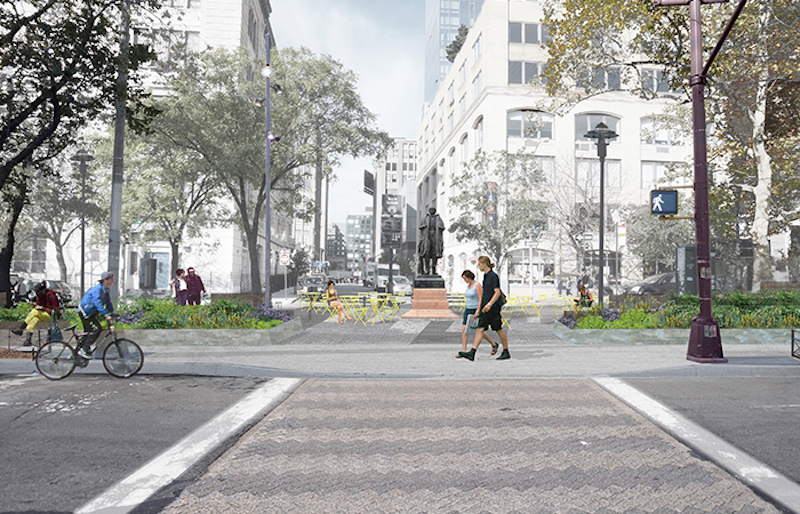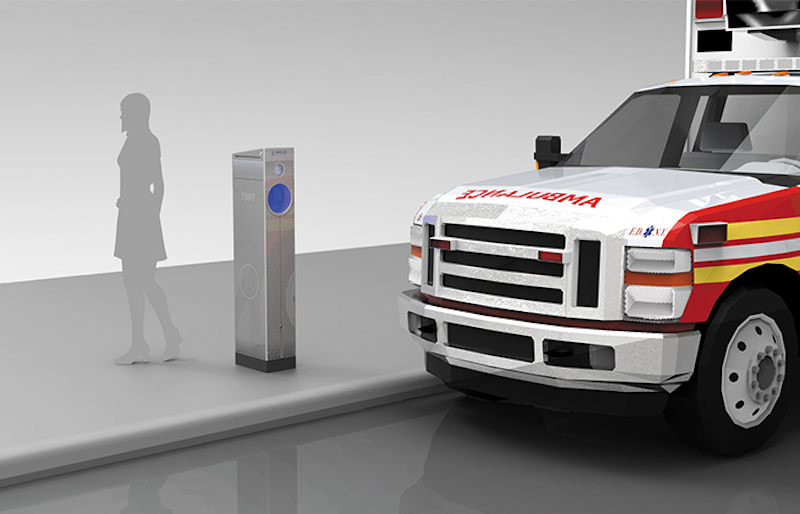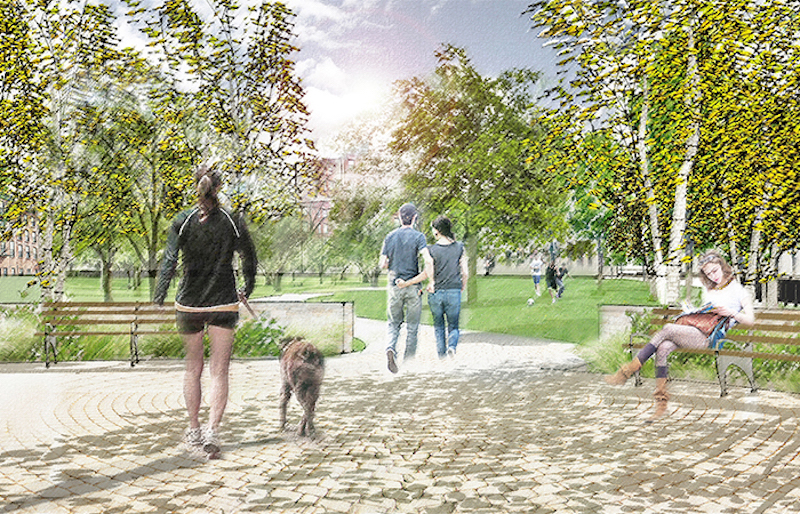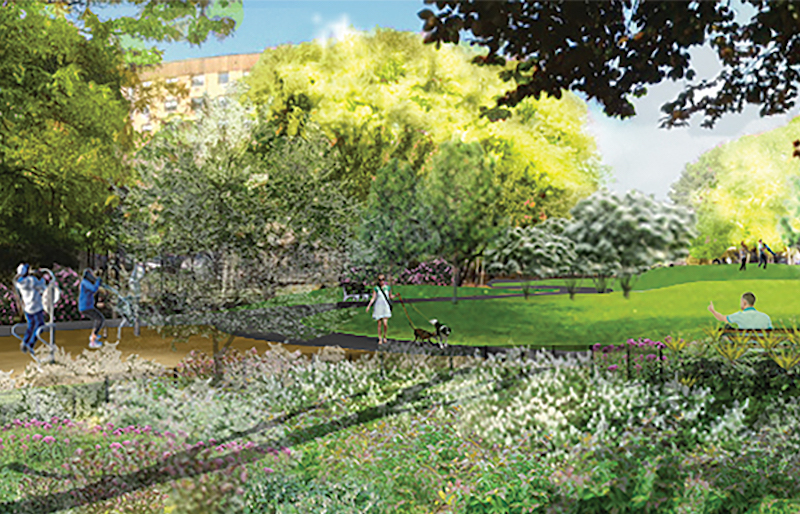Every year since 1983, New York City’s Public Design Commission has awarded projects with its Excellence in Design Awards, given to public projects in any of the city’s five boroughs. Selected from hundreds of submissions, the Commission reviewed the entries and chose 12 projects to receive the award for 2016. This year’s winning projects include police stations, parks, and anti-idling ambulance pedestals.
Each winning project is listed below with a short description from the NYC Public Design Commission. For more detail on any of the projects, click here. All images and project descriptions are courtesy of the NYC Public Design Commission.
40th Police Precinct
Bjarke Ingels Group + Starr Whitehouse
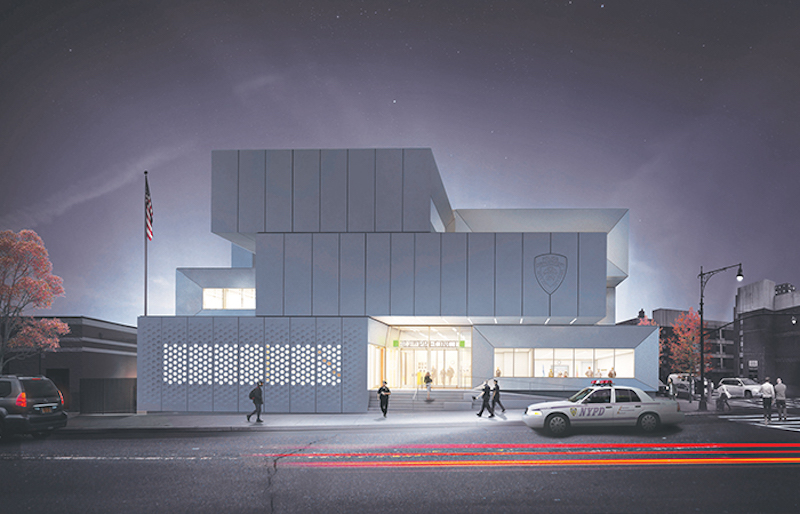
Located in the South Bronx, this new station house reinforces a commitment to serving the surrounding communities of Port Morris, Melrose, and Mott Haven while meeting the complex programmatic requirements of the New York City Police Department. The building's unique form comprises stacked volumes that spiral around a central atrium, visually connecting interior spaces and bringing in daylight from a rooftop clerestory. The facade alternates between solid perimeter walls and glazed reentrant corners, providing security while also affording light and views.
The 40th Precinct surpasses requirements for LEED Silver certification with features such as green roofs, high-albedo surfaces, bike racks, low-energy LED fixtures, and low-flow plumbing fixtures throughout. An exterior courtyard at the precinct's stress reduction room and a basketball half-court serve to promote mental health and activity within the workplace.
Waterfront Nature Walk by George Trakas
George Trakas + Quennell Rothschild & Partners

The first phase of this environmental sculpture, completed in 2007, explores the rich history of the waterway from its use by the Lenape prior to the arrival of Europeans, to the bustling 18th-and 19th-century waterfront cooperage, ship making and lumber industries along its shores, to its current context abutting New York City's largest, state-of-the-art wastewater treatment plant. These themes are drawn through dramatic site features, such as the 170-foot-long Vessel passage to the waterfront that evokes the angled timber construction of ships, and in details like trash receptacles designed to look like barrels, carefully selected plant material, and integrated graphics that have proven invaluable to DEP's educational program at the plant.
The second and third phases of the Waterfront Nature Walk, currently under way, extend the promenade over Whale Creek to create a continuous walkway that connects to the street grid on either side of the plant. These phases also expand the artist's conceptual focus from the local histories to ruminations on a broader history of ecology and human existence. The artist imbues public amenities such as bridged walkways, shade structures, benches, and drinking fountains with thought-provoking language, materials, and historical artifacts, notably the 385-million-year-old tree fossils unearthed at the Gilboa Dam in Schoharie County.
Van Name Van Pelt Plaza/Richmond Terrace Wetlands
Department of Parks & Recreation In-House Design
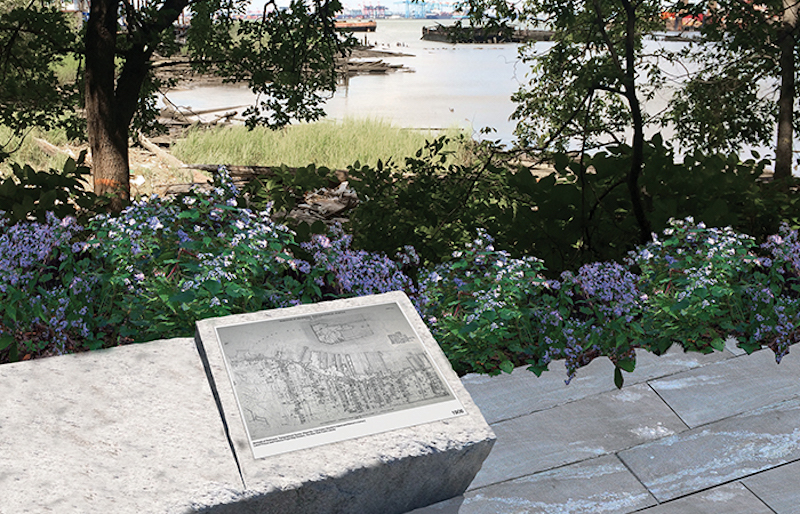
Nestled between the edge of a residential neighborhood and the working industrial waterfront of Staten Island's north shore, this deteriorated site will be transformed into an attractive community asset with a pier that provides expansive views to the Kill van Kull and the Bayonne Bridge. The entrance plaza at Richmond Terrace incorporates wooden guard rails, new lighting, benches, and bike racks and connects to a path threading through a woodland area. A short walk leads visitors to a gathering space that can be programmed for educational use and features engraved maps that describe the evolution of the island in relation to the waterway. Durable materials such as stone paving and concrete piles are utilized to withstand flooding, while woody understory and herbaceous planting in the wetland park increase shoreline resilience. The design prioritizes public access to the waterfront while preserving the wetlands and enhancing avian habitat.
Luminescence by Nobuho Nagasawa
Nobuho Nagasawa + Thomas Balsley Associates + Weiss/Manfredi Architects
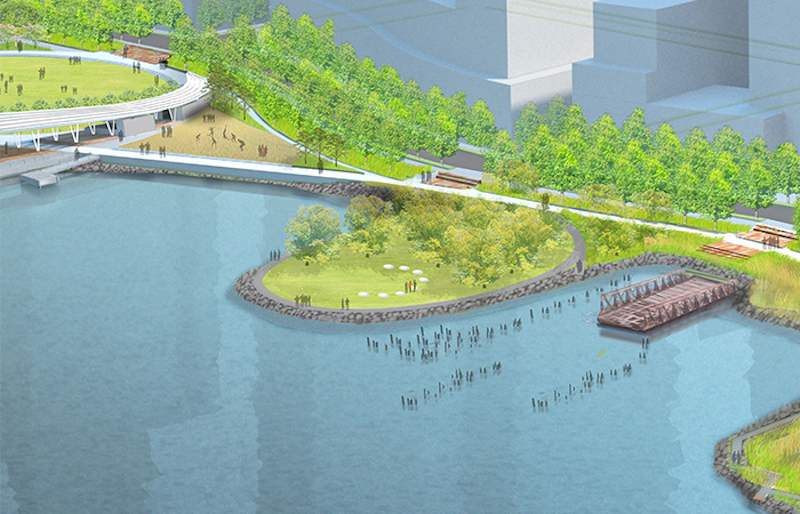
Set within the curved landscape of the Hunters Point South Peninsula lawn along the East River, these seven sculptures are both beautiful and educational. A phosphorescent material integrated into the surface of each domed shape absorbs sunlight during the day and illuminates the phases of the moon at night with a soft blue glow. Additionally, the concrete and aggregate sculptures are etched with the moon's pattern of craters, mountains and valleys. Placed at an overlook, the sculptures offer visitors the opportunity to contemplate the many influences of the moon - from its mystical and poetic powers to its physical gravitational pull on the river's tidal rhythm.
Dock 72
S9 Architecture + MPFP
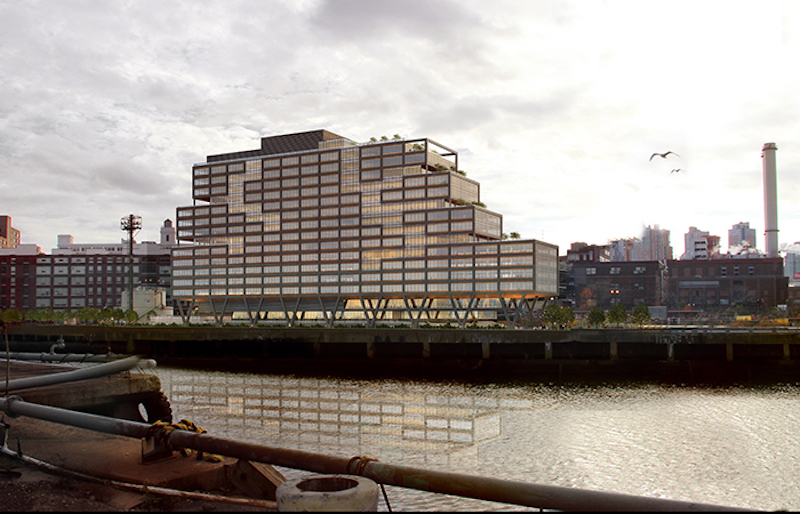
Dock 72 embraces rapidly emerging technological and creative industries in Brooklyn with a work environment that encourages and enables hundreds of new and maturing creative startups to flourish. The building's design celebrates the maritime and industrial history of the Brooklyn Navy Yard while providing 21st-century shared work spaces that allow tenants to contribute to the Yard's renewed life as a growing industrial hub. V-shaped columns lift the ship-like structure above the floodplain and form dual water and land access. The massing of the building steps down toward Wallabout Bay creating terraces with views of the surrounding Navy Yard, the East River, and Manhattan. Paths trace through the gridded facade, suggesting ant farm-like communal spaces and activities within. The building's open and flexible work environments encourage the interaction of people and foster the sharing of ideas, both of which are critical to development of innovative creative communities. Creating 4,000 living-wage jobs, this development is a key effort of the de Blasio administration's plan to double employment at the Navy Yard by 2020.
The High Line Park Passage and Spur
James Corner Field Operations + Diller Scofidio + Renfro + Piet Oudolf
The last segments of the High Line to open to the public, the Passage and Spur will become the northern gateway to this internationally loved elevated promenade. The Passage weaves through Hudson Yards' south tower, which cantilevers 60 feet above the High Line. To celebrate this cathedral-like space, the design remains open and minimal, with seating along the north edge and planting, social spaces, and balconies at the southern edge. The transition from the Passage to the Spur features a densely vegetated threshold of sloped planting beds. Here, a distinctive mix of large woodland trees will establish a dramatic 40-foot-tall canopy of lush greenery with an understory of ferns, broad-leaf groundcovers, and perennials. Perched above 10th Avenue and 30th Street, the Spur is envisioned as a piazza with amphitheater-like seating steps that surround a central plinth for a rotating art program. The Passage and Spur will offer expansive views, dense woodland plantings, ample public seating, and a large open space for public programming, as well as public bathrooms for High Line visitors. This project marks the culmination of nearly 20 years of work toward the transformation of this former rail line into a public treasure.
Snug Harbor Cultural Center Music Hall Addition
Studio Joseph + SCAPE/Landscape Architecture
This understated yet elegant addition will provide critical support spaces for the Snug Harbor Music Hall, which was completed in 1892 and is the second oldest theater in New York City. The new structure is nested carefully between two of the original pilasters on the east facade of the historic building. Modest in scale, with one floor below grade, the design achieves a sense of presence through formal expression - deep overhangs at the entrances recall the portico of the Music Hall - and materials such as white board-formed textured concrete, glass, and steel. The highly transparent facade brings unexpected natural light to back-of-house spaces that are typically dim, and the fully-glazed southeast corner offers views to an interior artwork, commissioned through the City's Percent for Art program. Outside the public entrance to the building, a landscaped courtyard and lawn provides flexible space for the Music Hall and Snug Harbor campus. This project will reinvigorate the historic theater, enhancing programmatic opportunities and operational efficiency that enable this cultural gem to put on its distinctive performances.
SoHo Square
Mathews Nielsen Landscape Architects
The renovation of this under-utilized open space will establish a distinct gateway to the thriving hub of Hudson Square. The design derives its patterns and materiality from the area's history as a printing district, while providing a variety of pathways, gathering areas, and seating to allow for diverse contemporary use of the site. Lush plantings provide a robust visual palette and permeable pavers and expanded tree pits enhance the overall health of the existing trees and capture stormwater runoff. A central focal point at the mid-block crossing will be anchored by the relocated statue of General Jose Artigas (1987) by Jose Luis Zorrilla de San Martin, which will be conserved as part of the project. This exemplary public-private partnership will create a pedestrian-friendly environment and improve the quality of life for the people who live and work in Hudson Square.
Anti-idling Ambulance Pedestals
Ignacio Ciocchini + MOVE Systems
Aligning with the sustainable goals of OneNYC, these anti-idling pedestals will reduce ambulance vehicle emissions without disrupting the Fire Department's critical emergency operations. By plugging in to these curbside pedestals, EMTs can safely shut off their engines while keeping their communication systems live and temperature-sensitive medicines refrigerated. The anti-idling pedestal's steel trapezoidal form efficiently accommodates the interior electrical components to minimize the structure's footprint. At the top of the pedestal, a back-lit perforated pattern acts as a beacon and indicates the functioning status of the pedestal. A circular, LED-lit polycarbonate access door is remotely activated by the user and opens to reveal the plug-in cable, which retracts automatically after use, allowing for a quick ambulance departure. This smart industrial design improves neighborhood air quality and ensures that the City's ambulances are ready to respond to emergencies at a moment's notice.
LinkNYC
CityBridge
LinkNYC is a new telecommunications network replacing old payphones with Links that benefit the public - especially those of limited means - by offering free services such as high-speed Wi-Fi, mobile device charging, and a custom-built tablet that enables free telephone calls within the United States and provides access to City information and services in addition to wayfinding. With a slim profile and durable materiality, the Links fit seamlessly into the city's diverse neighborhoods and streetscapes. The silver and black streamlined design is intended to complement the prototypical newsstands, bus shelters, and wayfinding signs throughout the city yet retain a distinct, easily-recognizable form. In an effort to decrease susceptibility to flooding damage, the main electrical components are situated high up within the kiosk. The resulting design is user-friendly, ADA compliant, and strong enough to stand up to life in New York City.
Parks Without Borders (Special Recognition award)
Department of Parks & Recreation
Rooted in the idea that the design of the public realm - streets, sidewalks, and open spaces - should be cohesive and integrated, Parks Without Borders aims to improve the interface between New York City parks and their surrounding neighborhoods. As part of OneNYC, this initiative aims to make parks more welcoming, accessible, and active. Each design concept will begin at the park edge, with lowered fences and gates, wider and more porous entrances, and improved sightlines into the park.
Community Parks Initiative (Special Recognition award)
Department of Parks & Recreation
Through the Community Parks Initiative (CPI), The Department of Parks & Recreation is strengthening New York City's network of parks and public space in historically under-served, high-poverty, densely populated and growing neighborhoods. Part of OneNYC, this multi-faceted capital program reimagines the smaller public parks that people use every day.
The first phase of CPI was announced in the fall of 2014 and will fully renovate 35 parks throughout all five boroughs. Developed with intensive community input from more than 1,100 members of the public, the park designs will ultimately transform 42 acres of urban parkland and reach a total population of 2.25 million residents, 31% of whom live below the poverty line.
For more information and additional images for each project, click here.
Related Stories
| Aug 11, 2010
ASHRAE releases free BIM introductory guide
A newly released guide from ASHRAE on building information models and building information modeling (BIM) serves as a resource for professionals considering BIM tools and applications for their businesses. According to "An Introduction to Building Information Modeling," BIM is “a digital representation of the physical and the functional characteristics of a facility.” Unlike 2D or 3D CAD, BIM software utilizes intelligent objects to create models.
| Aug 11, 2010
USGBC honors Brad Pitt's Make It Right New Orleans as the ‘largest and greenest single-family community in the world’
U.S. Green Building Council President, CEO and Founding Chair Rick Fedrizzi today declared that the neighborhood being built by Make It Right New Orleans, the post-Katrina housing initiative launched by actor Brad Pitt, is the “largest and greenest community of single-family homes in the world” at the annual Clinton Global Initiative meeting in New York.
| Aug 11, 2010
AIA report estimates up to 270,000 construction industry jobs could be created if the American Clean Energy Security Act is passed
With the encouragement of Senate majority leader Harry Reid (D-NV), the American Institute of Architects (AIA) conducted a study to determine how many jobs in the design and construction industry could be created if the American Clean Energy Security Act (H.R. 2454; also known as the Waxman-Markey Bill) is enacted.
| Aug 11, 2010
IFMA announces 2009-2010 executive committee and board of directors
The International Facility Management Association is pleased to announce its 2009-2010 executive committee and board of directors, which begin their terms July 1. Thomas L. Mitchell Jr., CFM, CFMJ, will serve as the new chair of the association’s board of directors, succeeding John McGee, MBA.
| Aug 11, 2010
Recreation facility scores with sustainable features
A new $79.1 million health and learning center is under construction on the Northern Arizona University campus in Flagstaff. The 270,000-sf facility will house recreation space, classrooms, health and counseling services, and the Lumberjack Stadium for track and soccer teams. Designed by the Phoenix office of OWP/P Cannon Design with Mortenson Construction as CM, the project is aiming for LEED ...
| Aug 11, 2010
Old factory converted from hearth to home
A former briquette factory in Cologne-Frechen, Germany, was converted into a mixed-use building by Astoc Architects & Planners, Cologne, in association with Rheinischen Amt für Denkmalpflege—the Rhenish agency for historic preservation. The roughly 172,200-sf building includes a mix of residential condominiums, lofts, and leased commercial space.
| Aug 11, 2010
Earthquake engineering keeps airport grounded
Istanbul, Turkey's new 2.15 million-sf Sabiha Gökçen International Airport opened on October 31, 2009, becoming the world's largest seismically isolated building. Arup's global airport planning and engineering team, in collaboration with architects Dogan Tekeli Sami Sisa Mimarlik Ofisi and contractor LIMAK-GMR JV, working within an 18-month timeline, designed and built the facility wi...
| Aug 11, 2010
University building gets revamped, reused
KSS Architects of Philadelphia is designing the addition and renovation to SUNY Cortland's Studio West, a 43,000-sf metal panel and brick building dating to 1948. The 20,000-sf, two-story addition will become the Professional Studies Building, housing the consolidated departments of Recreation, Parks, and Leisure Studies; Communications Disorders and Sciences; and Kinesiology and Sports Managem...
| Aug 11, 2010
High-density planning allows abundant open space
Gilroy Unified School District's new Christopher High School in California opened its first phase this fall. The 1,800-student, 231,000-sf facility was designed with a high-density site plan that allows for both on-site sports fields and undeveloped open space. BCA Architects of Fremont, Calif., with Gilbane Building Companies as CM, collaborated with numerous user groups to plan the two-story,...



